Every Angeleno Counts: The 2020 Census in Los Angeles
Every ten years, the federal government conducts a “census,” where it counts every person living in the United States. The constitution mandates that all people – including children and adults, the employed and unemployed, immigrants, renters and homeowners – must be counted. In March of 2020, households throughout Los Angeles County will receive a mailing with instructions on how to complete their census form online, by phone or by mail. The form will ask ten simple questions around things like race, age, marital status and household size. Despite the fact that the census usually takes a household just ten minutes to complete each decade, it is one of the most important parts of a representative democracy..
The Importance of the Census
The first Census took place in 1790. By 2010, the Census was the United States’ largest peacetime mobilization effort –employing over 630,000 “census takers” to help ensure an accurate count of roughly 309 million people living in all 50 states. Because the United States is a representative democracy (meaning that political representation is based on population), understanding the number of residents is essential to ensure that everyone gets a fair share of political representation and government resources. For example, the Census is used to determine how many officials each state can elect to the U.S. House of Representatives.
Information collected in the census is also used to make important decisions like how much money our schools should receive and how much goes to support health care for our loved ones. In fact, more than $675 billion in federal funding each year that goes toward services like education programs, housing development, healthcare services and job training is based on census data. By understanding how many people live in our communities, Los Angeles has the opportunity to get the resources it needs to thrive over the next decade.



Hard-to-Count Populations
While the Census aims to count all residents of the United States, historically, it has missed many people. Immigrants, young children, Black Americans, Asian Americans, Latinos, Native Americans, Pacific Islanders, low-income communities, people with disabilities, renters, and people experiencing homelessness are some of the groups who are most likely to go uncounted in the census. Ironically, these “hard-to-count” communities have the most to gain from an accurate census count, but are often discouraged from participating.
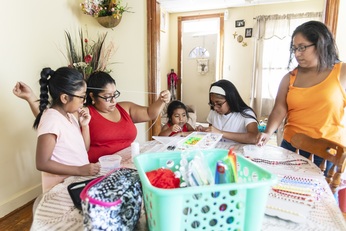
A variety of factors make certain populations hard to count including language barriers, lack of internet access, frequent moving between residences, and distrust of government. Renters, who move more frequently than homeowners, may experience confusion about where to fill out the census if they’ve recently moved. In large family households, infants and young children may get left off of the census form as families often list members in order of age on a paper form with limited space. Gentrification and displacement also increases the hard-to-count population as low income communities of color are pushed out of cities into new areas with less infrastructure and resources for community outreach.
Los Angeles County & the 2020 Census
An accurate count of Los Angeles County residents in the 2020 Census is crucial. The California Department of Finance projects that the county’s population will grow by half a million people in the next decade, and ensuring an accurate count of all current residents will be especially important to obtain the federal resources needed to keep up with population growth. More than $650 million in federal funding was lost in Los Angeles County due to an undercount in the 2010 census. As one of the largest and most diverse counties in the nation, Los Angeles has much to gain, and much to lose, in the upcoming 2020 census.

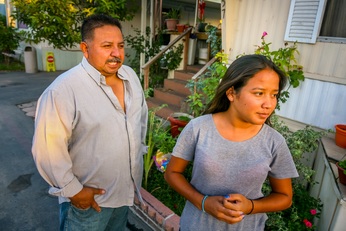
Los Angeles County is also the hardest-to-count county in the United States. Nearly 5.2 million residents – making up half of the county’s population – are considered hard to count. The Census Bureau developed a measure called the “Low Response Score” to predict which areas will have the lowest response rates in the 2020 census, with a higher score indicating that less people will respond. In Los Angeles, the most important factors in the low response score were education levels, poverty, housing and ethnicity. The Census Bureau notes that for the upcoming census, outreach to people with lower incomes, renters, people with less than a high school education, and people of color will be particularly important in Los Angeles County.
In addition to factors that have traditionally led to the undercounting of certain populations, new response and outreach methods will also make traditionally underserved populations more difficult to count. The 2020 Census will mark the first time that the internet will be the primary response option census questionnaire. For the 20% of households in Los Angeles County who do not have an internet subscription (as of 2017 American Community Survey estimates), this poses new challenges for responding to the census.

In addition to new response methods, the U.S. Department of Commerce directed the Census Bureau to add a question about citizenship status to the 2020 Census, citing the need to improve enforcement of the Voting Rights Act. Opponents of this decision contested it in court, arguing that the citizenship question’s presence will result in an undercount of immigrants, many of whom, out of an escalating fear of deportation in the current political climate, will choose not to respond to the Census. In June 2019, the case reached the U.S. Supreme Court, which rejected the Department of Commerce’s rationale for adding the question and ruled in a 5-4 decision to send the case back to the district court, at least temporarily preventing the question from appearing on the 2020 Census. Even without the question on the Census, issues around citizenship and distrust of government remain – a recent study by Pew found that 66% of foreign-born Latinos and 43% of U.S.-born Latinos are worried about the deportation of a close friend or family member, regardless of their own citizenship status. These issues are magnified in Los Angeles County, where 48% of the population identifies as Latino and over a third are immigrants.
The Los Angeles Regional Census Table
Given the scale of the enumeration challenge posed by the 2020 Census in Los Angeles County, California Community Foundation and Advancement Project California have partnered to create the Los Angeles Regional Census Table. The Table is a space for trusted community-based organizations to coordinate outreach efforts to effectively reach hard-to-count populations. This network is divided into six different regions in Los Angeles County – each of whom coordinate hyperlocal census outreach activities. In the southeast region of the county, where challenges to census participation are particularly high, the Southeast Los Angeles (SELA) Collaborative is leading the regional effort to ensure an accurate count of their community.
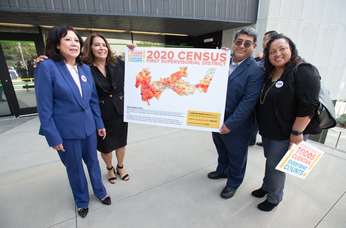

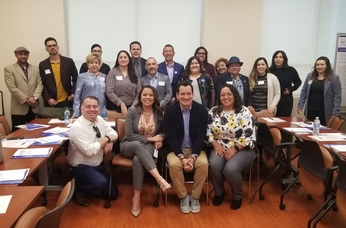
Southeast Los Angeles
The southeast region of the county (the 8 cities and 2 unincorporated areas shown on the map below) is home to 437,000 people, 94% of whom identify as Latino and 43% of whom are immigrants. As of 2016 estimates, the median income in the southeast was just over $40,600, significantly lower than the median income for the county ($57,900). Alarmingly, communities in the southeast are at a high-risk of an undercount. These neighborhoods are home to many people that the Census Bureau has flagged as critical for increased outreach in the 2020 Census including people of color, limited-English speaking households, renters, and people with less than a high school education. The chart below shows the share of these hard-to-count populations in the southeast region compared to Los Angeles County and California.
Because of the prevalence of these hard-to-count populations, the vast majority of southeast neighborhoods also had high scores on the Low Response Score metric, meaning that the Census Bureau predicts low participation in the 2020 Census without any additional outreach effort. In fact, 92% of census block groups across southeast neighborhoods scored “high” or “very high” on the Low Response Score metric. Hover over a census block group on the map below to see its Low Response Score and demographic characteristics.
The SELA Collaborative
A complete count of Southeast Los Angeles residents during the 2020 Census is critical to ensuring that southeast communities are represented in our democracy and receive critical services and supports across education, crime prevention, health care, and transportation. In response to the southeast area’s need for increased outreach around the Census, the SELA Collaborative, a network of organizations, has made the 2020 Census one of its priority areas and joined the Los Angeles Regional Census Table as a regional lead. In that role, the SELA Collaborative convenes community-based organizations throughout the region to discuss strategies for outreach to hard-to-count populations specific to the southeast region.
Given the large immigrant presence in the southeast, fear around the citizenship question has been an important topic during Census Table discussions in the southeast. Community-based organizations are building a multi-lingual campaign to inform communities about the importance of the census and present facts around the privacy laws in place protecting answers to all questions, including the citizenship question. The SELA Collaborative and its partner organizations are confident that as evident in prior acts of great resiliency, instead of being paralyzed by fear, immigrant communities will courageously be counted in the census as an act of standing up for inclusion and fairness.
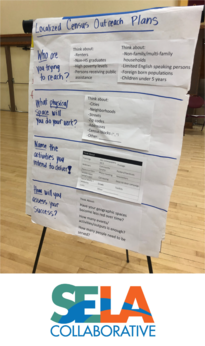
Visit the Los Angeles Regional Census Table’s website to learn more about local census participation efforts in your region and follow the California Complete Count on Twitter for updates on the census in California. To connect with the Los Angeles Regional Census Table directly, please reach out to Alejandra Ramírez-Zárate at Advancement Project California (azarate@advanceproj.org).
Elly Schoen
Sources
Advancement Project CA. (2018a). Los Angeles Counts 2020: A General Plan for a Regional Census Outreach Campaign. Retrieved from https://www.advancementprojectca.org/wp-content/uploads/2018/09/Los-Angeles-Counts-2020_A-General-Plan_FINAL.pdf
Advancement Project CA. (2018b). Los Angeles Regional Census Table. Retrieved from https://www.advancementprojectca.org/what-we-do/political-voice/2020-census/los-angeles-regional-census-table/
Census Policy Advocacy Network. (2019). Everyone Wins When Everyone is Counted. Retrieved from https://www.advancementprojectca.org/wp-content/uploads/2019/03/CPAN_LobbyKit_FULL_FINAL.pdf
Lopez, M., Gonzalez-Barrera, A., & Krogstad, J. (2019). More Latinos Have Serious Concerns About Their Place in America Under Trump. Retrieved from https://www.pewhispanic.org/2018/10/25/more-latinos-have-serious-concerns-about-their-place-in-america-under-trump/
State of California Department of Finance. (2019). Demographic Projections. Retrieved from http://www.dof.ca.gov/Forecasting/Demographics/Projections/
The Brennan Center for Justice. (2019). The Voting Rights Act. Retrieved from https://www.brennancenter.org/issues/the-voting-rights-act
United States Census Bureau. (2017). The Low Response Score. Retrieved from http://planning.lacounty.gov/assets/img/gis/agol/TheLowResponseScore_background_info_Nov2017.pdf
United States Census Bureau. (2018). 2020 Census Research, Operational Plans, and Oversight. Retrieved from https://www.census.gov/programs-surveys/decennial-census/2020-census/about/why.html
Photo Attributions
Cover Photo: Photo courtesy of Istock/liveslow
Photo 1: Photo courtesy of Istock/FatCamera
Photo 2: Photo courtesy of Istock/P_Wei
Photo 3: Photo courtesy of Istock/monkeybusinessimages
Photo 4: Photo courtesy of Istock/Alex Potemkin
Photo 5: Photo courtesy of Istock/jjwithers
Photo 6: Photo courtesy of Istock/Photo Beto
Photo 7: Photo courtesy of Istock/kali9
Photos 8-11: Photos courtesy of SELA Collaborative

